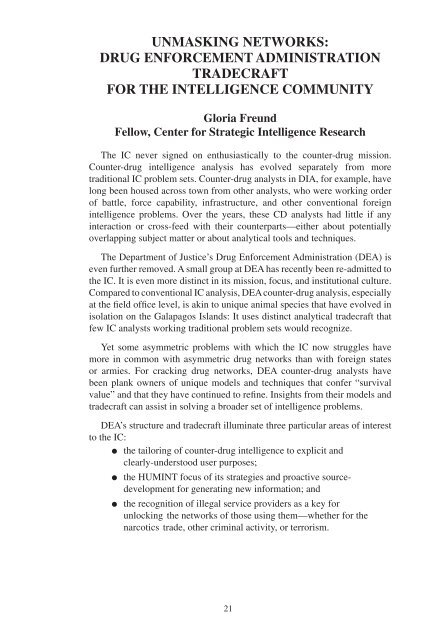Improving the Law-Enforcement-Intelligence Community Relationship
Improving the Law-Enforcement-Intelligence Community Relationship
Improving the Law-Enforcement-Intelligence Community Relationship
You also want an ePaper? Increase the reach of your titles
YUMPU automatically turns print PDFs into web optimized ePapers that Google loves.
UNMASKING NETWORKS:<br />
DRUG ENFORCEMENT ADMINISTRATION<br />
TRADECRAFT<br />
FOR THE INTELLIGENCE COMMUNITY<br />
Gloria Freund<br />
Fellow, Center for Strategic <strong>Intelligence</strong> Research<br />
The IC never signed on enthusiastically to <strong>the</strong> counter-drug mission.<br />
Counter-drug intelligence analysis has evolved separately from more<br />
traditional IC problem sets. Counter-drug analysts in DIA, for example, have<br />
long been housed across town from o<strong>the</strong>r analysts, who were working order<br />
of battle, force capability, infrastructure, and o<strong>the</strong>r conventional foreign<br />
intelligence problems. Over <strong>the</strong> years, <strong>the</strong>se CD analysts had little if any<br />
interaction or cross-feed with <strong>the</strong>ir counterparts—ei<strong>the</strong>r about potentially<br />
overlapping subject matter or about analytical tools and techniques.<br />
The Department of Justice’s Drug <strong>Enforcement</strong> Administration (DEA) is<br />
even fur<strong>the</strong>r removed. A small group at DEA has recently been re-admitted to<br />
<strong>the</strong> IC. It is even more distinct in its mission, focus, and institutional culture.<br />
Compared to conventional IC analysis, DEA counter-drug analysis, especially<br />
at <strong>the</strong> field office level, is akin to unique animal species that have evolved in<br />
isolation on <strong>the</strong> Galapagos Islands: It uses distinct analytical tradecraft that<br />
few IC analysts working traditional problem sets would recognize.<br />
Yet some asymmetric problems with which <strong>the</strong> IC now struggles have<br />
more in common with asymmetric drug networks than with foreign states<br />
or armies. For cracking drug networks, DEA counter-drug analysts have<br />
been plank owners of unique models and techniques that confer “survival<br />
value” and that <strong>the</strong>y have continued to refine. Insights from <strong>the</strong>ir models and<br />
tradecraft can assist in solving a broader set of intelligence problems.<br />
DEA’s structure and tradecraft illuminate three particular areas of interest<br />
to <strong>the</strong> IC:<br />
● <strong>the</strong> tailoring of counter-drug intelligence to explicit and<br />
clearly-understood user purposes;<br />
● <strong>the</strong> HUMINT focus of its strategies and proactive sourcedevelopment<br />
for generating new information; and<br />
● <strong>the</strong> recognition of illegal service providers as a key for<br />
unlocking <strong>the</strong> networks of those using <strong>the</strong>m—whe<strong>the</strong>r for <strong>the</strong><br />
narcotics trade, o<strong>the</strong>r criminal activity, or terrorism.<br />
21
















